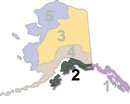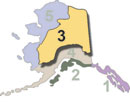Black bears are common to Alaska and are distributed across most of the state. Colors may vary from coal black to bluish-black to cinnamon, and even nearly blonde. A regional genetic mutation exists in the Yakutat area and parts of Region 1 (Southeast). Some bears in that area have a bluish tint and are locally known as "glacier bears"). There is both a spring and a fall season, and in many areas, the seasonal harvest limit is very liberal; up to three bears per hunter.
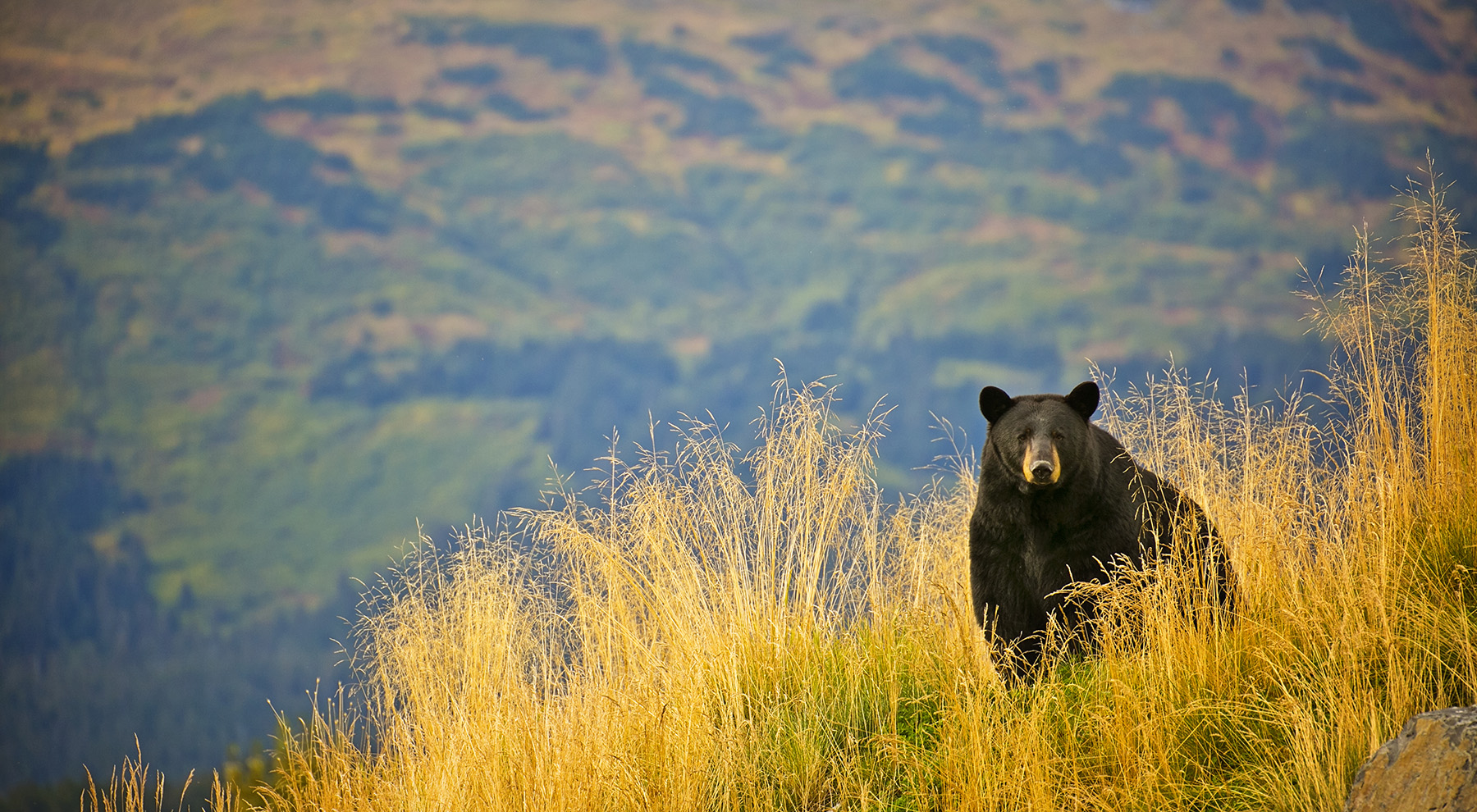
Though there are some exceptions (mostly in cases where bears are feeding on carrion), black bear meat is valued by many hunters as table fare. Many hunters also utilize the fat for cooking purposes. Black bear hides are prized as well, especially prime hides with their thick, glossy hair. Many hunters are primarily interested in the hides, presumably because they are unaware that the meat can be quite good. One of the keys to obtaining good black bear meat is to choose the time and place you are hunting carefully. Generally bears taken in alpine blueberry patches in the fall can be very good, as are bears that have recently emerged from their dens. Bears that have had the opportunity to dine on carrion or the flesh of other animals are not nearly as palatable as those that are feeding on vegetation.
Seasons
Black bears are hunted in both the spring and the fall. In some parts of the state, the season never closes. Spring hunts typically occur in April and May, and may even run into June. After the middle of June, though, the hides are usually rubbed or shed out enough to cause hunters to lose interest in harvesting them. By the middle of summer, most bear hunters put up the guns and bows and turn their attention to other pursuits while they wait for the fall season. Black bear hunting typically resumes in late August for some, but really kicks into high gear in September and October, and lasts until the bears den up in the latter part of October.
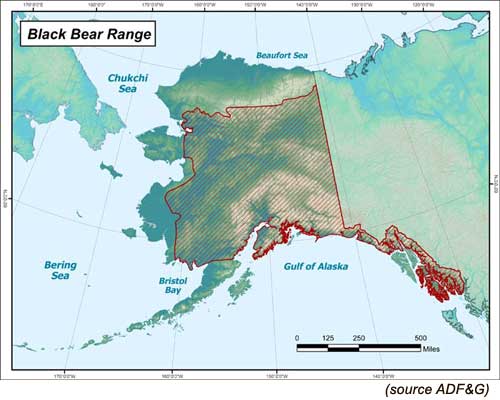 Distribution in Alaska
Distribution in Alaska
Black bears, like most species in Alaska, are unequally distributed around the state. Regional populations fluctuate primarily because of the availability of food sources such as prey species (small mammals, the calves of larger ungulates such as moose or deer, or salmon) or berry crops. When food supplies are low, bears will move out of an area.
Region 1 (Southeast Panhandle)
Game Management Units: GMU 1, 2, 3, 4 & 5
Region 1 South: Southeast Panhandle | Region 1 North: Yakutat / Cordova Area
Available species:
Black Bear | Brown / Grizzly Bear | Deer | Elk | Goat | Moose | Wolf
Southeast Alaska has a thriving black bear population. Because much of the area is timbered, however, hunting tactics must be adjusted to fit the conditions. In the spring, bears emerge from their dens and often make a beeline for intertidal zones where they feed on emerging grass and other vegetation, kelp, and even carrion that has washed up with the tide. A technique that works well in the late spring and fall months is to glass clear-cut areas or other openings for bears feeding in berry patches. Some of the better areas to hunt blackies in Southeast are Prince of Wales Island (POW), Kuiu Island, and other islands throughout the region. The mainland also offers excellent opportunities. There are no black bears on Admiralty, Baranof, or Chicagof (ABC) islands, or Kruzof island, presumably because of the large brown bear population in those areas.
Region 2 (North Gulf Coast, Kenai Peninsula, Kodiak / Afognak Archipelago)
Game Management Units: GMU 6, 7, 8, 14C, 15
Region 2 East: North Gulf Coast / Kenai Peninsula | Region 2 West: Kodiak / Afognak Archipelago
Available species:
Bison | Black Bear | Brown / Grizzly Bear | Caribou | Dall Sheep | Deer | Elk | Goat | Moose | Wolf
Black bears are common on the Kenai Peninsula, but completely absent on Montague island, and the Kodiak-Afognak archipelago. This absence is probably because of the relatively dense brown bear populations in those areas (brown bears are Alaska's primary predators of black bears). That said, brown / grizzly bears cohabit the same terrain throughout the rest of the region. Hunting tactics consist mostly of spot-and-stalk in both the spring and the fall. In the spring, look for dirt streaks in the snow, running straight downhill of dens. Bears tend to push dirt out of their dens as they dig out, and they will often emerge for a while, lay out on the snow a while, then return to the den site a few times before finally heading down to the low country. The result is that the snow around the den becomes tracked up a bit and can be easy to spot from the valley floor. In the fall months, glass the same hillsides; especially south-facing slopes. These slopes receive direct sunlight during summer and in good berry years, the blueberry crop will be most abundant in these areas. Bears will be seen up high in these maroon-colored patches, gorging themselves on blueberries.
Region 3 (Interior, central & eastern Brooks Range)
Game Management Units: GMU 12, 19, 20, 21, 24, 25, 26B, 26C
Region 3 East: Eastern Arctic / Eastern Interior | Region 3 West: Central Interior
Available species:
Bison | Black Bear | Brown / Grizzly Bear | Caribou | Dall Sheep | Moose | Wolf
Black bears do not inhabit the north side of the Brooks Range, and the population on the south side of the range is spotty. So if you plan to hunt black bears in the Brooks, it's best to consider them incidental to something else. Blackies can be found throughout the rest of the interior. Methods include spot-and-stalk tactics in the spring and the fall months, along with baiting in the spring. Baiting usually involves setting up a tree stand near the bait station. Some hunters set trail cams up near the bait station so they can monitor what species of bear is hitting the bait, in case the signs are not obvious. If a brown/grizzly hits your bait, it's usually best to move the bait station, as brown bears tend to dominate the site and will keep black bears away. It is not legal to hunt brown bears over bait in Alaska. Occasionally black bears are taken during moose or caribou season if they take over a carcass of an animal killed by a hunter. It pays to glass your moose and caribou kill sites from time to time.
Region 4 (Southcentral, Alaska Peninsula, Aleutians)
Game Management Units: GMU 9, 10, 11, 13, 14A, 14B, 16, 17
Region 4 East: Southern Interior, Anchorage, Susitna Valley | Region 4 West: Bristol Bay and the Alaska Peninsula
Available species:
Bison | Black Bear | Brown / Grizzly Bear | Caribou | Dall Sheep | Goat | Moose | Wolf
Black bears are not found west of the Lake Iliamna area, but the rest of the region has plenty of black bears to go around. Glass for bears emerging from dens in the spring. Some hillsides are visible directly from the road system, and others require a hike in; perhaps on skis or snowshoes. If you have access to a jet boat, consider scouting along some of the river systems that receive spring hooligan (eulachon) runs. Some rivers to keep in mind are the Susitna and the Twentymile; both of them receive spring runs. Black bears may be found along the banks, especially as the hooligan spawn out and die. The runs occur in the month of May; check our Dipnetting forum for trip reports that indicate the strength and precise timing of the run. Another popular spring technique involves baiting. This is particularly popular in the Mat-Su Valley area. Baiting usually involves setting a tree stand a short distance from the bait station. Because the bait is a known distance from the stand, it is relatively simple for archers to take reliable kill shots on bears in these circumstances. Some families expose their children to hunting in this way and many a young man or woman has taken their first big-game animal over a bait station in Region 4. In the fall months, bears can be found high in the berry patches, and can often be glassed from the valley floor or from an opposing hillside. Watch the bear carefully to ensure he is not grazing through the area quickly; it can often take several hours to climb to the location where the bear was last seen, only to discover that he has moved on and is impossible to locate. It is difficult to glass a mountain that you are on. Better to watch for bears that are laying up in the afternoon or those that have found a particularly abundant berry patch. They may linger long enough to allow a quick ascent to a shooting position.
Region 5 (Western Brooks Range, west coast to Bristol Bay)
Game Management Units: GMU 18, 22, 23, 26A
Region 5 North: Western Arctic | Region 5 South: Yukon / Kuskokwim Delta
Available species:
Black Bear | Brown / Grizzly Bear | Caribou | Dall Sheep | Moose | Muskox | Wolf
Region 5 is the most sparsely-populated black bear area in the state. You will not generally find them north of the Brooks Range, or on the Seward Peninsula, the Yukon-Kuskokwim delta, or on any of the islands off the west coast. Some bears may be found in parts of GMU 23, 22A, and the eastern parts of GMU 18. Because the region is not mountainous, and contains a lot of open tundra, concentrate your efforts in areas that allow glassing of vegetated areas. In the fall, your best shot is to hope for a bear on your moose or caribou kill. Black bears should be considered an incidental take in Region 5.
Black Bear Hunting Tactics
Spot and Stalk
The most common and effective technique for hunting black bears in Alaska is the spot and stalk method. This is true in both the spring and fall seasons. Early spring hunters look for vertical dirt streaks formed by bears emerging from snow-covered dens. Bears frequently emerge from a den but may linger in the area for as much as a few days, entering and exiting the den multiple times. In so doing, they often leave muddy footprints in the snow, which are visible from some distance. Do your glassing from the bottom of the valley or an opposing slope. Spring days in Alaska are often long, offering many hours of prime glassing opportunity.
Fall hunters should concentrate their glassing efforts on hillside berry patches. Black bears commonly feed on several types of berries that mature in late summer. The most prolific alpine varieties are blueberries, followed by huckleberries (high-bush 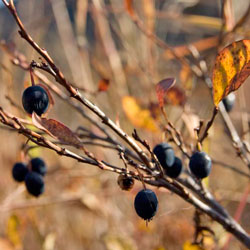 blueberries), bear berries, and crowberries. In wooded areas, you will sometimes find high-bush cranberries, and though bears do feed on these, they are not usually found in large enough concentrations to be worth glassing. Add that to the fact that they grow in wooded areas, with poor visibility. Blueberry leaves turn a deep maroon color, as do the leaves of bear berries, and these patches of berries can often be seen from a distance. Glass these areas in the morning or evening hours when bears are out feeding. Once a bear is spotted, you must first determine whether there are cubs nearby. The hunting regulations prohibit the taking of sows with young cubs. Next, determine the wind direction and then plan your stalk accordingly.
blueberries), bear berries, and crowberries. In wooded areas, you will sometimes find high-bush cranberries, and though bears do feed on these, they are not usually found in large enough concentrations to be worth glassing. Add that to the fact that they grow in wooded areas, with poor visibility. Blueberry leaves turn a deep maroon color, as do the leaves of bear berries, and these patches of berries can often be seen from a distance. Glass these areas in the morning or evening hours when bears are out feeding. Once a bear is spotted, you must first determine whether there are cubs nearby. The hunting regulations prohibit the taking of sows with young cubs. Next, determine the wind direction and then plan your stalk accordingly.
Hunting over Kills
Although the Alaska hunting regulations prohibit the use of game meat as bait, it is perfectly legal to hunt bears over the carcasses of other animals you have taken. Black bears will readily consume the remains of a moose or caribou, and even the carcasses of other bears, including brown bears. It may take three or more days for a 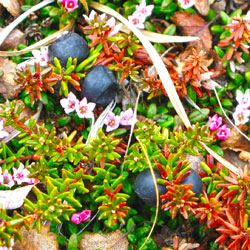 bear to locate a kill, so be patient and glass from a distance, to avoid contaminating the area with your scent. If you kill a moose or other ungulate, and you would like to hunt a black bear over that kill, jam a long branch into the carcass and secure some surveyor's tape to the tip of the stick. You will be able to see this from a distance. When a bear gets on a kill, they almost always relocate the carcass, and if the stick is knocked over, there's a good chance a bear has claimed the carcass and is feeding on it. Keep a sharp eye out and you may get your bear!
bear to locate a kill, so be patient and glass from a distance, to avoid contaminating the area with your scent. If you kill a moose or other ungulate, and you would like to hunt a black bear over that kill, jam a long branch into the carcass and secure some surveyor's tape to the tip of the stick. You will be able to see this from a distance. When a bear gets on a kill, they almost always relocate the carcass, and if the stick is knocked over, there's a good chance a bear has claimed the carcass and is feeding on it. Keep a sharp eye out and you may get your bear!
Baiting
Baiting is a popular method of harvesting black bears in some parts of Alaska. Hunters must pass a certification in bear-baiting, and the rules are in a constant state of change. CLICK HERE for details on the requirements, recommended procedures, and methods involved. Baiting is done in the spring and typically involves hauling food items and other attractants to a likely location, where the bait station is set up. A tree stand is erected nearby, from which the shot is taken. Great care is used in managing human scent at a bait station. In most cases, it is illegal for brown/grizzly bears to be taken over bait. Hunters often use trail cameras to determine the species of the bear hitting the bait. If a brown bear starts hitting the bait station, it usually means the end of any black bear opportunities on that bait station, as brown bears will dominate the area until all the bait is gone. All bait and attractants must be removed from the site at the conclusion of hunting, and not later than the close of the season.
Calling
Calling black bears is gaining in popularity and, in the right conditions, it can be just the thing to get a bear moving in your direction. Use a "dying rabbit" or squeaker to pull reluctant bears in your direction, but be very careful, as you could attract a bear you are not aware of. In some cases, they come running at full-tilt and you could have trouble if you are not extra-careful.
Hounds
Though commonly practiced elsewhere, the use of dogs to pursue and tree black bears is not legal in Alaska.
Additional Resources on Black Bear Hunting
Here is a list of additional resources on black bear biology, hunting tactics, meat, and trophy care, and protecting yourself from problem bears.
Black Bear Biology
- Alaska's Mammals, by Dave Smith
- Animal Tracks Alaska, by Sheldon & Hartson
- The Nature of Alaska, by James Kavanaugh
- Wild Mammals of North America, Feldhammer, Thompson, and Chapman
Black Bear Hunting
- Ask the Black Bear Guides, by J.Y. Jones
- Bear Hunting in Alaska, by Tony Russ
- Float Hunting Alaska's Wild Rivers, by Michael Strahan
- Hunting Alaska's Coastal Giants DVD, with Glacier Guides, Inc.
- Hunting the Hunters, by Rick Kinmon
- Radical Bear Hunter, by Dick Scorzafava
- The Education of a Bear Hunter, by Ralph Flowers (trapping in the Pacific Northwest)
- Perfect Shot Black Bear Targets
Bear Stories
- Alaska Bear Tales, by Larry Kaniut
- Alaska More Bear Tales, by Larry Kaniut
- Bears & Flowers, by Ralph Flowers
Meat and Trophy Care
- Field Care Handbook, by Duncan Gilchrist and Bill Sager
- Skinning & Field Care of Alaska Bears (DVD), by Chris Batin (about brown bears, but the techniques apply)
- Take a Closer Look (DVD), by the Alaska Department of Fish & Game
Cookbooks
- Best of the Best from Alaska, by McKee & Moseley
- Cooking Big Game, by Scott and Tiffany Haugen
- The Meateater Fish and Game Cookbook by Steve Rinella
Protecting Yourself from Problem Bears
- Alaska Magnum Bear Safety Manual, by Stephen Stringham
- Bear Attacks, by Stephen Herrero
- Bear Attacks of the Century, by Marguerite Reis
- Bear vs Man, by Brad Garfield
- Outwitting Bears, by Gary Brown


